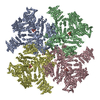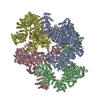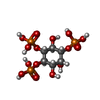[English] 日本語
 Yorodumi
Yorodumi- PDB-6dr0: Class 5 IP3-bound human type 3 1,4,5-inositol trisphosphate receptor -
+ Open data
Open data
- Basic information
Basic information
| Entry | Database: PDB / ID: 6dr0 | ||||||
|---|---|---|---|---|---|---|---|
| Title | Class 5 IP3-bound human type 3 1,4,5-inositol trisphosphate receptor | ||||||
 Components Components | Inositol 1,4,5-trisphosphate receptor type 3 | ||||||
 Keywords Keywords | METAL TRANSPORT / Ion channel / Calcium channel | ||||||
| Function / homology |  Function and homology information Function and homology informationDAG and IP3 signaling / inositol 1,3,4,5 tetrakisphosphate binding / sensory perception of bitter taste / inositol 1,4,5-trisphosphate-gated calcium channel activity / platelet dense tubular network membrane / sensory perception of umami taste / Effects of PIP2 hydrolysis / sensory perception of sweet taste / PLC beta mediated events / Elevation of cytosolic Ca2+ levels ...DAG and IP3 signaling / inositol 1,3,4,5 tetrakisphosphate binding / sensory perception of bitter taste / inositol 1,4,5-trisphosphate-gated calcium channel activity / platelet dense tubular network membrane / sensory perception of umami taste / Effects of PIP2 hydrolysis / sensory perception of sweet taste / PLC beta mediated events / Elevation of cytosolic Ca2+ levels / inositol 1,4,5 trisphosphate binding / inositol hexakisphosphate binding / CLEC7A (Dectin-1) induces NFAT activation / transport vesicle membrane / cytoplasmic side of endoplasmic reticulum membrane / intracellularly gated calcium channel activity / brush border / nuclear outer membrane / Role of phospholipids in phagocytosis / calcium ion homeostasis / Ion homeostasis / release of sequestered calcium ion into cytosol / FCERI mediated Ca+2 mobilization / phosphatidylinositol binding / FCGR3A-mediated IL10 synthesis / Antigen activates B Cell Receptor (BCR) leading to generation of second messengers / secretory granule membrane / sarcoplasmic reticulum / VEGFR2 mediated cell proliferation / Regulation of insulin secretion / response to calcium ion / platelet activation / memory / long-term synaptic potentiation / apical part of cell / Sensory perception of sweet, bitter, and umami (glutamate) taste / Glucagon-like Peptide-1 (GLP1) regulates insulin secretion / sensory perception of taste / positive regulation of cytosolic calcium ion concentration / Ca2+ pathway / protein homotetramerization / receptor complex / G protein-coupled receptor signaling pathway / neuronal cell body / calcium ion binding / endoplasmic reticulum membrane / nucleolus / endoplasmic reticulum / zinc ion binding / nucleoplasm / ATP binding / membrane / plasma membrane / cytoplasm Similarity search - Function | ||||||
| Biological species |  Homo sapiens (human) Homo sapiens (human) | ||||||
| Method | ELECTRON MICROSCOPY / single particle reconstruction / cryo EM / Resolution: 4.47 Å | ||||||
 Authors Authors | Hite, R.K. / Paknejad, N. | ||||||
 Citation Citation |  Journal: Nat Struct Mol Biol / Year: 2018 Journal: Nat Struct Mol Biol / Year: 2018Title: Structural basis for the regulation of inositol trisphosphate receptors by Ca and IP. Authors: Navid Paknejad / Richard K Hite /  Abstract: Inositol trisphosphate receptors (IPRs) are ubiquitous Ca-permeable channels that mediate release of Ca from the endoplasmic reticulum, thereby regulating numerous processes including cell division, ...Inositol trisphosphate receptors (IPRs) are ubiquitous Ca-permeable channels that mediate release of Ca from the endoplasmic reticulum, thereby regulating numerous processes including cell division, cell death, differentiation and fertilization. IPRs are jointly activated by inositol trisphosphate (IP) and their permeant ion, Ca. At high concentrations, however, Ca inhibits activity, ensuring precise spatiotemporal control over intracellular Ca. Despite extensive characterization of IPR, the mechanisms through which these molecules control channel gating have remained elusive. Here, we present structures of full-length human type 3 IPRs in ligand-bound and ligand-free states. Multiple IP-bound structures demonstrate that the large cytoplasmic domain provides a platform for propagation of long-range conformational changes to the ion-conduction gate. Structures in the presence of Ca reveal two Ca-binding sites that induce the disruption of numerous interactions between subunits, thereby inhibiting IPR. These structures thus provide a mechanistic basis for beginning to understand the regulation of IPR. | ||||||
| History |
|
- Structure visualization
Structure visualization
| Movie |
 Movie viewer Movie viewer |
|---|---|
| Structure viewer | Molecule:  Molmil Molmil Jmol/JSmol Jmol/JSmol |
- Downloads & links
Downloads & links
- Download
Download
| PDBx/mmCIF format |  6dr0.cif.gz 6dr0.cif.gz | 2.8 MB | Display |  PDBx/mmCIF format PDBx/mmCIF format |
|---|---|---|---|---|
| PDB format |  pdb6dr0.ent.gz pdb6dr0.ent.gz | Display |  PDB format PDB format | |
| PDBx/mmJSON format |  6dr0.json.gz 6dr0.json.gz | Tree view |  PDBx/mmJSON format PDBx/mmJSON format | |
| Others |  Other downloads Other downloads |
-Validation report
| Summary document |  6dr0_validation.pdf.gz 6dr0_validation.pdf.gz | 1.4 MB | Display |  wwPDB validaton report wwPDB validaton report |
|---|---|---|---|---|
| Full document |  6dr0_full_validation.pdf.gz 6dr0_full_validation.pdf.gz | 1.4 MB | Display | |
| Data in XML |  6dr0_validation.xml.gz 6dr0_validation.xml.gz | 195.3 KB | Display | |
| Data in CIF |  6dr0_validation.cif.gz 6dr0_validation.cif.gz | 303.6 KB | Display | |
| Arichive directory |  https://data.pdbj.org/pub/pdb/validation_reports/dr/6dr0 https://data.pdbj.org/pub/pdb/validation_reports/dr/6dr0 ftp://data.pdbj.org/pub/pdb/validation_reports/dr/6dr0 ftp://data.pdbj.org/pub/pdb/validation_reports/dr/6dr0 | HTTPS FTP |
-Related structure data
| Related structure data |  7987MC  7978C  7979C  7980C  7981C  7982C  7983C  7984C  7985C  7986C  7988C  7989C  7990C  7991C  7992C  7993C  7994C  7995C  7996C  6dqjC  6dqnC  6dqsC  6dqvC  6dqzC  6dr2C  6draC  6drcC M: map data used to model this data C: citing same article ( |
|---|---|
| Similar structure data |
- Links
Links
- Assembly
Assembly
| Deposited unit | 
|
|---|---|
| 1 |
|
- Components
Components
| #1: Protein | Mass: 304488.688 Da / Num. of mol.: 4 Source method: isolated from a genetically manipulated source Source: (gene. exp.)  Homo sapiens (human) / Gene: ITPR3 / Production host: Homo sapiens (human) / Gene: ITPR3 / Production host:  Homo sapiens (human) / References: UniProt: Q14573 Homo sapiens (human) / References: UniProt: Q14573#2: Chemical | ChemComp-ZN / #3: Chemical | ChemComp-I3P / Has protein modification | Y | |
|---|
-Experimental details
-Experiment
| Experiment | Method: ELECTRON MICROSCOPY |
|---|---|
| EM experiment | Aggregation state: PARTICLE / 3D reconstruction method: single particle reconstruction |
- Sample preparation
Sample preparation
| Component | Name: human type 3 inositol 1,4,5-trisphosphate receptor / Type: ORGANELLE OR CELLULAR COMPONENT / Entity ID: #1 / Source: RECOMBINANT | |||||||||||||||||||||||||||||||||||
|---|---|---|---|---|---|---|---|---|---|---|---|---|---|---|---|---|---|---|---|---|---|---|---|---|---|---|---|---|---|---|---|---|---|---|---|---|
| Molecular weight | Experimental value: NO | |||||||||||||||||||||||||||||||||||
| Source (natural) | Organism:  Homo sapiens (human) Homo sapiens (human) | |||||||||||||||||||||||||||||||||||
| Source (recombinant) | Organism:  Homo sapiens (human) / Strain: HEK 293S GnTi / Plasmid: BacMam Homo sapiens (human) / Strain: HEK 293S GnTi / Plasmid: BacMam | |||||||||||||||||||||||||||||||||||
| Buffer solution | pH: 8 Details: 150mM Nacl 50mM Tris-HCl, pH 8.0 2mM DTT 0.06% Digitonin 5mM EGTA 50 micromolar IP3 | |||||||||||||||||||||||||||||||||||
| Buffer component |
| |||||||||||||||||||||||||||||||||||
| Specimen | Conc.: 8 mg/ml / Embedding applied: NO / Shadowing applied: NO / Staining applied: NO / Vitrification applied: YES Details: type 3 inositol 1,4,5-trisphosphate receptor in detergent micelles | |||||||||||||||||||||||||||||||||||
| Specimen support | Grid material: GOLD / Grid mesh size: 400 divisions/in. / Grid type: Quantifoil R1.2/1.3 | |||||||||||||||||||||||||||||||||||
| Vitrification | Instrument: FEI VITROBOT MARK IV / Cryogen name: ETHANE / Humidity: 100 % / Chamber temperature: 293 K / Details: Blot for 2 seconds prior to freezing |
- Electron microscopy imaging
Electron microscopy imaging
| Experimental equipment |  Model: Titan Krios / Image courtesy: FEI Company |
|---|---|
| Microscopy | Model: FEI TITAN KRIOS |
| Electron gun | Electron source:  FIELD EMISSION GUN / Accelerating voltage: 300 kV / Illumination mode: FLOOD BEAM FIELD EMISSION GUN / Accelerating voltage: 300 kV / Illumination mode: FLOOD BEAM |
| Electron lens | Mode: BRIGHT FIELD / Nominal magnification: 22500 X / Nominal defocus min: 1000 nm / Cs: 2.7 mm / C2 aperture diameter: 70 µm / Alignment procedure: COMA FREE |
| Specimen holder | Cryogen: NITROGEN / Specimen holder model: FEI TITAN KRIOS AUTOGRID HOLDER |
| Image recording | Average exposure time: 8 sec. / Electron dose: 61 e/Å2 / Detector mode: SUPER-RESOLUTION / Film or detector model: GATAN K2 SUMMIT (4k x 4k) / Num. of grids imaged: 1 / Num. of real images: 4519 |
| Image scans | Sampling size: 5 µm / Width: 7420 / Height: 7676 / Movie frames/image: 40 / Used frames/image: 1-40 |
- Processing
Processing
| EM software |
| |||||||||||||||||||||||||||
|---|---|---|---|---|---|---|---|---|---|---|---|---|---|---|---|---|---|---|---|---|---|---|---|---|---|---|---|---|
| Image processing | Details: Movie frames were aligned with MotionCor2 | |||||||||||||||||||||||||||
| CTF correction | Type: PHASE FLIPPING AND AMPLITUDE CORRECTION | |||||||||||||||||||||||||||
| Particle selection | Num. of particles selected: 302966 | |||||||||||||||||||||||||||
| 3D reconstruction | Resolution: 4.47 Å / Resolution method: FSC 0.143 CUT-OFF / Num. of particles: 27334 / Algorithm: FOURIER SPACE / Num. of class averages: 1 / Symmetry type: POINT | |||||||||||||||||||||||||||
| Atomic model building | B value: 217 / Protocol: AB INITIO MODEL / Space: REAL / Target criteria: map-to-model FSC |
 Movie
Movie Controller
Controller








 PDBj
PDBj























